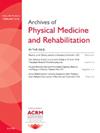Lessons from Refining a Focus Group Protocol with Veterans: Adapted Think-alouds and Accommodated Focus Groups for Persons with Traumatic Brain Injury 8263
IF 3.6
2区 医学
Q1 REHABILITATION
Archives of physical medicine and rehabilitation
Pub Date : 2025-04-01
DOI:10.1016/j.apmr.2025.01.027
引用次数: 0
Abstract
Objectives
To improve research involving people with traumatic brain injury (TBI), Project I-HEAL sought to refine a focus group guide for those who may have cognitive challenges. Think-alouds (Van Someren et al., 1994) were used, but were adapted so participants could best evaluate the guide. The guide's purpose was to elicit data on acceptable practices during in-patient rehabilitation from veterans with TBI.
Design
Four mixed-method qualitative sessions were used: 1 unstructured focus group (Brinkmann, 2014), 2 adapted think-alouds, and 1 structured focus group guide pilot.
Setting
The setting was virtual (ie, Teams). Participants were a veteran research engagement group from a VA hospital.
Participants
Seven participants (4 persons with TBI and 3 caregivers) participated in the first and fourth session. The second and third sessions each comprised a subsample of 2 couples (1 person with TBI and their caregiver).
Interventions
The first session included study overview and participant-driven discussion about practices in which researchers should engage. This was followed by adapted think-aloud sessions in which real-time modifications to the guide based on feedback were made. Then, a pilot was done to test focus group guide usability.
Main Outcome Measures
Outcome measures were the feedback given in the first session (ie, general advice about veterans with TBI and their caregivers participating in research), the second and third sessions (ie, specific item rephrasing offered by participants), and the fourth session (ie, determinations of whether people understood items).
Results
In session 1, participants’ comments coalesced around 2 themes: researchers should provide materials to participants in advance; researchers should allow plenty of time for participants’ cognition. In sessions 2-3, participants offered rephrasing of items to reduce cognitive burden, such as by suggesting direct and shorter sentences. In session 4, the refined guide was piloted successfully, although it took more time than other focus groups due to cognitive processing time needed and requests for redirection and repetition.
Conclusions
This novel, adapted think-aloud procedure offers advantages over others that organize and analyze think-aloud data using codebooks with feedback being used to later revise measures (eg, Ahmadi et al., 2022; Kleyen et al., 2017). Using the present novel approach, researchers can ensure they are understanding feedback accurately and participants can articulate whether changes speak to their feedback. In addition, to allow for participant cognition (Norman et al., 2019), research using focus groups with participants with TBI may benefit from allotting 50% more time and including fewer members (ie, 4 participants rather than 6-8).
Disclosures
none.
求助全文
约1分钟内获得全文
求助全文
来源期刊
CiteScore
6.20
自引率
4.70%
发文量
495
审稿时长
38 days
期刊介绍:
The Archives of Physical Medicine and Rehabilitation publishes original, peer-reviewed research and clinical reports on important trends and developments in physical medicine and rehabilitation and related fields. This international journal brings researchers and clinicians authoritative information on the therapeutic utilization of physical, behavioral and pharmaceutical agents in providing comprehensive care for individuals with chronic illness and disabilities.
Archives began publication in 1920, publishes monthly, and is the official journal of the American Congress of Rehabilitation Medicine. Its papers are cited more often than any other rehabilitation journal.

 求助内容:
求助内容: 应助结果提醒方式:
应助结果提醒方式:


